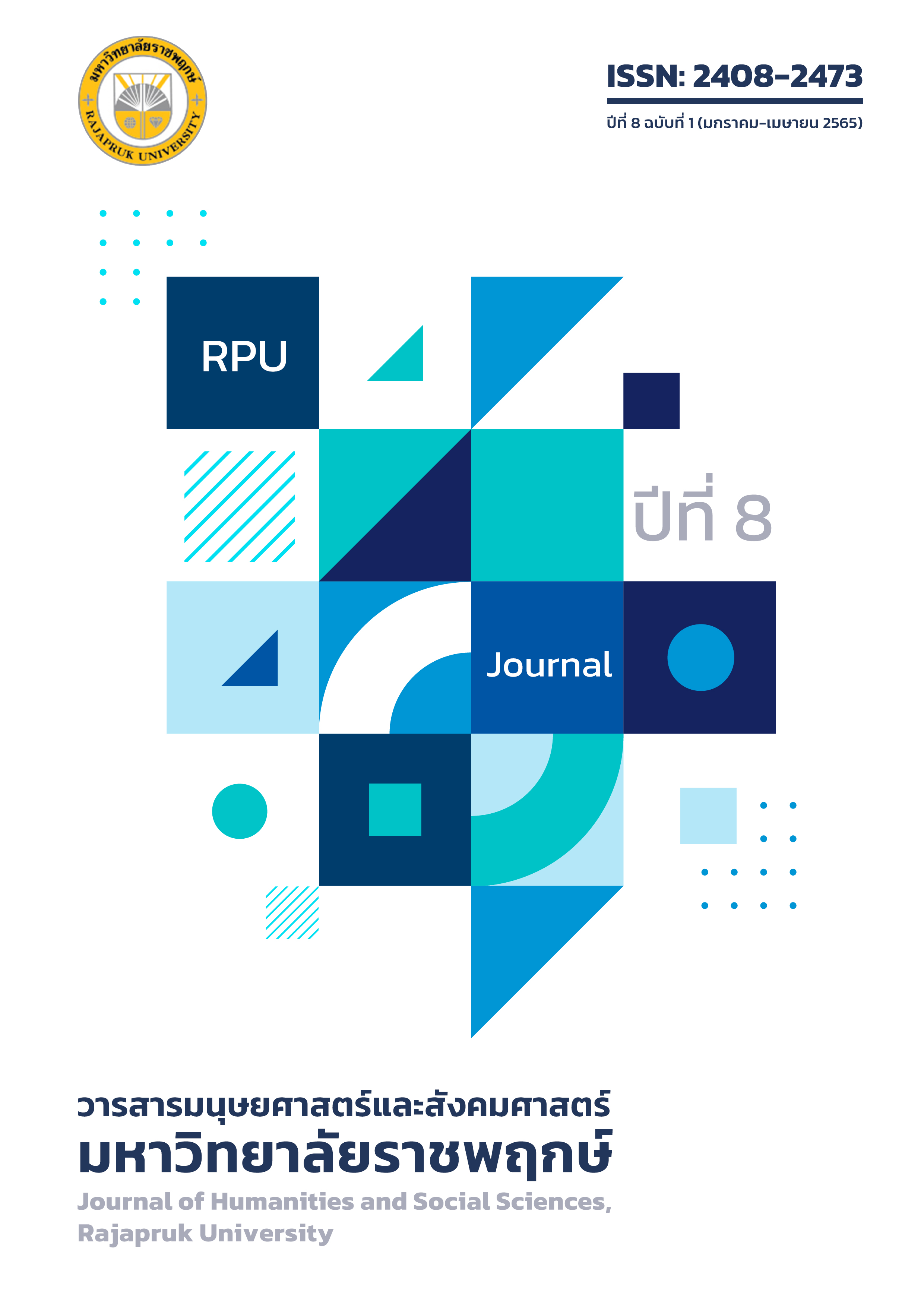Development of Self-Efficacy Learning Management Program in HIV Prevention for At-Risk Youth in the Bangkok Metropolitan Area
Main Article Content
Abstract
At the present, HIV transmission has still been an important problem in Thailand. HIV prevention needs solutions urgently, especially among At-Risk Youth. This study was to develop for synthesis and evaluate a self-efficacy Learning Management Program in HIV prevention for at-risk youth in the Bangkok Metropolitan Area. Self-efficacy theory by Albert Bandura was applied as a theoretical framework for self-efficacy. This study was divided into three phases: Phase I: developing the program by a systematic review of the literature and using in-depth, semi-structured interviews by Snowball determines with 6 Active sexual youth leadership participants. Phase II: the program's intervention consisted of 13 active sexual youths with no condom. Phase III: a program evaluation of the effects with 10 participants as phase II. Data were collected by quantitative and qualitative methods. Wilcoxon Signed Rank Test for Matched Paired Deference was used to analyze quantitative data.
The results found that:
1. The components of the self-efficacy learning management program in HIV prevention for at-risk youth in the Bangkok metropolitan included 4activities about 1 hour per activity by focusing on mastery experience. Including 1)ransack success/ persuasion/ recall restraint/ spicy phrase or picture activity 2) persuasion pass model/ verify success 3) remind activity and 4) recognization activity/ verify success/ 4 sources of self-efficacy.
2. After joining the program found that the mean pre-test and post-test mean scores were statistically different at the .05 level. The program was developed to be appropriate and enhance self-efficacy in HIV prevention for at-risk youth in Bangkok.
Article Details
References
กองควบคุมโรคเอดส์ วัณโรคและโรคติดต่อทางเพศสัมพันธ์. (2562). ผลการคาดประมาณสถานการณ์การแพร่ระบาดของ HIV/AIDS ในกรุงเทพมหานคร ตั้งแต่ปี พ.ศ.2561-2573 เพื่อการป้องกันและแก้ไขปัญหาเอดส์.นนทบุรี: ร้านธนพรพาณิช.
ทนงศรี ภูริศรี, อนันต์ มาลารัตน์ และ ไพบูลย์ อ่อนมั่ง.(2558). รูปแบบการจัดการเรียนรู้เรื่องเอดส์ และเพศศึกษาสำหรับนักเรียนระดับชั้นมัธยมศึกษา.วารสารควบคุมโรค, 41(4): 241-252.
บุรเทพ โชคธนานุกุล และ กมลชนก ขำสุวรรณ. (2559). การตั้งครรภ์ในวัยรุ่น ผลกระทบทางสังคมจากมุมมองเรื่องเพศของแม่ต่างรุ่น.วารสารประชากร, 4(2): 61-79.
ประไพวรรณ ด่านประดิษฐ์ เปรมวดีคฤหเดช อุดมพร ยิ่งไพบูลย์สุข บุญศรี กิตติโชติพาณิชย์ และผ่องศรี สวยสม. (2561). ผลของโปรแกรมการประยุกต์ใช้ทฤษฎีความสามารถตนเอง และการสร้างเสริมทักษะชีวิตต่อความมั่นใจในการหลีกเลี่ยง การมีเพศสัมพันธ์และการป้องกันการตั้งครรภ์ในนักเรียนวัยรุ่นหญิงกลุ่มเสี่ยงทางเพศ. วารสารพยาบาลศาสตร์ จุฬาลงกรณ์มหาวิทยาลัย, 30(1): 11-22.
พรรัมภา ขวัญยืน. (2557). การบริหารการช่วยเหลือวัยรุ่นตั้งครรภ์ไม่พึงประสงค์ในจังหวัดเชียงใหม่.การประชุมวิชาการ การพัฒนาชนบทที่ยั่งยืน ครั้งที่ 4. (หน้า 236-242). เชียงใหม่: วิทยาลัยบริหารศาสตร์ มหาวิทยาลัยแม่โจ้.
วนิดา ปาวรีย์. (2557). พฤติกรรมการใช้ถุงยางอนามัยเพื่อการป้องกันโรคติดต่อทางเพศสัมพันธ์ของประชาชนในชุมชนวัดสีสุก เขตจอมทอง กรุงเทพมหานคร. สถาบันอุดมศึกษาแห่งประเทศไทย (สสอท.),20(2): 148-157.
วฤษสพร ณัฐรุจิโรจน์. (2560). การขับเคลื่อนเพื่อการป้องกันและแก้ไขปัญหาการตั้งครรภ์ไม่พร้อมในวัยรุ่น. วารสารสังคมศาสตร์ มหาวิทยาลัยศรีนครินทรวิโรฒ, 20(1): 216-229.
วัลยา ธรรมพนิชวัฒน์ และ เบ็ญจมาศ โอฬารรัตน์มณี. (2561). เพศศึกษาสำหรับวัยรุ่นในโรงเรียน: กรณีศึกษาในกรุงเทพมหานคร.วารสารสภาการพยาบาล, 33(3): 82-98.
Affendi, I., Muhamad, N.A., Normi, M., Hatta, M., Aliza, N., Sabtuah, Md., Farid, Md., Zanariah, Z. &Suraiya, S.M. (2018). Association between self-efficacy and health behaviour in disease control: A systematic review. Global Journal of Health Science, 10(1): 18-36.
Bandura, A. (1986). Social foundations of thought and action.New Jersey: Prentice-Hall.
Department of Medical Sciences, Ministry of Public Health.(2014). 20 years with condom.Nonthaburi: JS Printing House.
HIV INFO HUB. (2020). คาดประมาณผู้ติดเชื้อเอชไอวี.Retrieved January, 12, 2021,from https://hivhub.ddc.moph.go.th/epidemic.php
Ingvild, F. S. et al.(2012). Targeting condom distribution at high risk places increases condom utilization-evidence from an intervention study in Livingstone, Zambia.BMC Public Health.12(10): 1-12.
Li, H., Xue, L., Tucker, J.D., Wei, C., Durvasula, M., Hu, W., Kang, D., Liao, M., Tang, W. & Ma, W. (2017). Condom use peer norms and self-efficacy as mediators between community engagement and condom use among Chinese men who have sex with men. BMC Public Health Journal, 17(641): 1-8.
Margaret, C. S. et al. (2014). Relationship between social cognitive theory constructs and self-reported condom use: assessment of behavior in a subgroup of the Safe in the City trial. BMJ open. 4(10): 1-6.
Michelle, R. K. et al. (2014). Health Behavior Change Models for HIV Prevention and AIDS Care: Practical Recommendations for a Multi-Level Approach. Acquire Immune DeficSyndr. 66(3): 250-258.
Ritchwood, T. D., Penn, D., Peasant, C., Albritton, T., and Giselle, C.S. (2017).Condom use self-efficacy among younger rural adolescents: The influence of parent-teen communication, and knowledge of and attitudes toward condoms.Journal of Early Adolescence, 37(2): 267-283.
UNAIDS. (2020). Global HIV & AIDS statistics. Retrieved January, 12, 2021,from https://www.unaids.org/en/resources/fact-sheet


